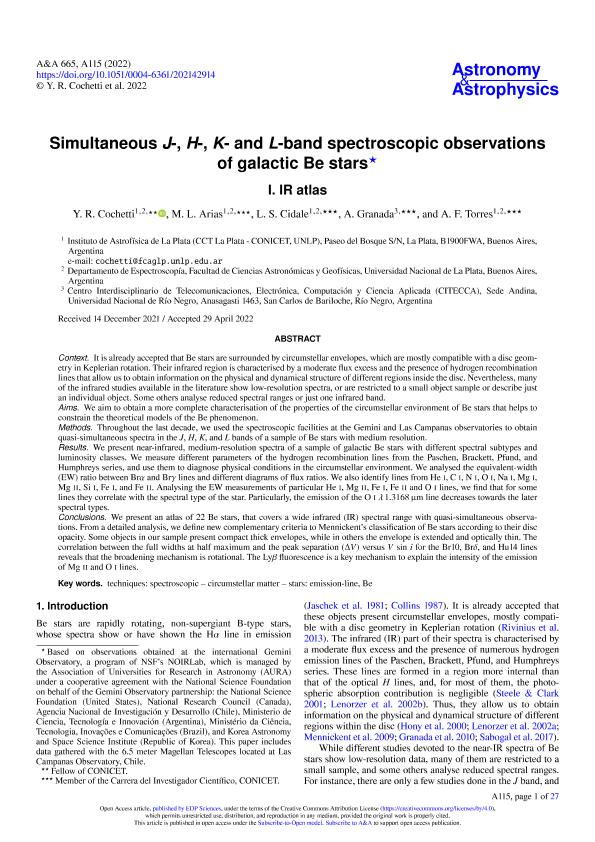Mostrar el registro sencillo del ítem
dc.contributor.author
Cochetti, Yanina Roxana

dc.contributor.author
Arias, María Laura

dc.contributor.author
Cidale, Lydia Sonia

dc.contributor.author
Granada, Anahi

dc.contributor.author
Torres, Andrea Fabiana

dc.date.available
2023-10-04T15:35:09Z
dc.date.issued
2022-09
dc.identifier.citation
Cochetti, Yanina Roxana; Arias, María Laura; Cidale, Lydia Sonia; Granada, Anahi; Torres, Andrea Fabiana; Simultaneous J -, H -, K - and L -band spectroscopic observations of galactic Be stars; EDP Sciences; Astronomy and Astrophysics; 665; 9-2022; 1-27
dc.identifier.issn
0004-6361
dc.identifier.uri
http://hdl.handle.net/11336/214094
dc.description.abstract
Context. It is already accepted that Be stars are surrounded by circumstellar envelopes, which are mostly compatible with a disc geometry in Keplerian rotation. Their infrared region is characterised by a moderate flux excess and the presence of hydrogen recombination lines that allow us to obtain information on the physical and dynamical structure of different regions inside the disc. Nevertheless, many of the infrared studies available in the literature show low-resolution spectra, or are restricted to a small object sample or describe just an individual object. Some others analyse reduced spectral ranges or just one infrared band. Aims. We aim to obtain a more complete characterisation of the properties of the circumstellar environment of Be stars that helps to constrain the theoretical models of the Be phenomenon. Methods. Throughout the last decade, we used the spectroscopic facilities at the Gemini and Las Campanas observatories to obtain quasi-simultaneous spectra in the J, H, K, and L bands of a sample of Be stars with medium resolution. Results. We present near-infrared, medium-resolution spectra of a sample of galactic Be stars with different spectral subtypes and luminosity classes. We measure different parameters of the hydrogen recombination lines from the Paschen, Brackett, Pfund, and Humphreys series, and use them to diagnose physical conditions in the circumstellar environment. We analysed the equivalent-width (EW) ratio between Brα and Brγ lines and different diagrams of flux ratios. We also identify lines from He i, C i, N i, O i, Na i, Mg i, Mg ii, Si i, Fe i, and Fe ii. Analysing the EW measurements of particular He i, Mg ii, Fe i, Fe ii and O i lines, we find that for some lines they correlate with the spectral type of the star. Particularly, the emission of the O i λ 1.3168 μm line decreases towards the later spectral types. Conclusions. We present an atlas of 22 Be stars, that covers a wide infrared (IR) spectral range with quasi-simultaneous observations. From a detailed analysis, we define new complementary criteria to Mennickent's classification of Be stars according to their disc opacity. Some objects in our sample present compact thick envelopes, while in others the envelope is extended and optically thin. The correlation between the full widths at half maximum and the peak separation (V) versus V sin i for the Br10, Brδ, and Hu14 lines reveals that the broadening mechanism is rotational. The Lyβ fluorescence is a key mechanism to explain the intensity of the emission of Mg ii and O i lines.
dc.format
application/pdf
dc.language.iso
eng
dc.publisher
EDP Sciences

dc.rights
info:eu-repo/semantics/openAccess
dc.rights.uri
https://creativecommons.org/licenses/by/2.5/ar/
dc.subject
CIRCUMSTELLAR MATTER
dc.subject
STARS: EMISSION-LINE, BE
dc.subject
TECHNIQUES: SPECTROSCOPIC
dc.subject.classification
Astronomía

dc.subject.classification
Ciencias Físicas

dc.subject.classification
CIENCIAS NATURALES Y EXACTAS

dc.title
Simultaneous J -, H -, K - and L -band spectroscopic observations of galactic Be stars
dc.type
info:eu-repo/semantics/article
dc.type
info:ar-repo/semantics/artículo
dc.type
info:eu-repo/semantics/publishedVersion
dc.date.updated
2023-09-14T17:22:16Z
dc.journal.volume
665
dc.journal.pagination
1-27
dc.journal.pais
Francia

dc.journal.ciudad
Paris
dc.description.fil
Fil: Cochetti, Yanina Roxana. Consejo Nacional de Investigaciones Científicas y Técnicas. Centro Científico Tecnológico Conicet - La Plata. Instituto de Astrofísica La Plata. Universidad Nacional de La Plata. Facultad de Ciencias Astronómicas y Geofísicas. Instituto de Astrofísica La Plata; Argentina
dc.description.fil
Fil: Arias, María Laura. Consejo Nacional de Investigaciones Científicas y Técnicas. Centro Científico Tecnológico Conicet - La Plata. Instituto de Astrofísica La Plata. Universidad Nacional de La Plata. Facultad de Ciencias Astronómicas y Geofísicas. Instituto de Astrofísica La Plata; Argentina
dc.description.fil
Fil: Cidale, Lydia Sonia. Consejo Nacional de Investigaciones Científicas y Técnicas. Centro Científico Tecnológico Conicet - La Plata. Instituto de Astrofísica La Plata. Universidad Nacional de La Plata. Facultad de Ciencias Astronómicas y Geofísicas. Instituto de Astrofísica La Plata; Argentina
dc.description.fil
Fil: Granada, Anahi. Consejo Nacional de Investigaciones Científicas y Técnicas; Argentina. Universidad Nacional de Río Negro; Argentina
dc.description.fil
Fil: Torres, Andrea Fabiana. Consejo Nacional de Investigaciones Científicas y Técnicas. Centro Científico Tecnológico Conicet - La Plata. Instituto de Astrofísica La Plata. Universidad Nacional de La Plata. Facultad de Ciencias Astronómicas y Geofísicas. Instituto de Astrofísica La Plata; Argentina
dc.journal.title
Astronomy and Astrophysics

dc.relation.alternativeid
info:eu-repo/semantics/altIdentifier/url/https://www.aanda.org/articles/aa/full_html/2022/09/aa42914-21/aa42914-21.html
dc.relation.alternativeid
info:eu-repo/semantics/altIdentifier/doi/http://dx.doi.org/10.1051/0004-6361/202142914
Archivos asociados
